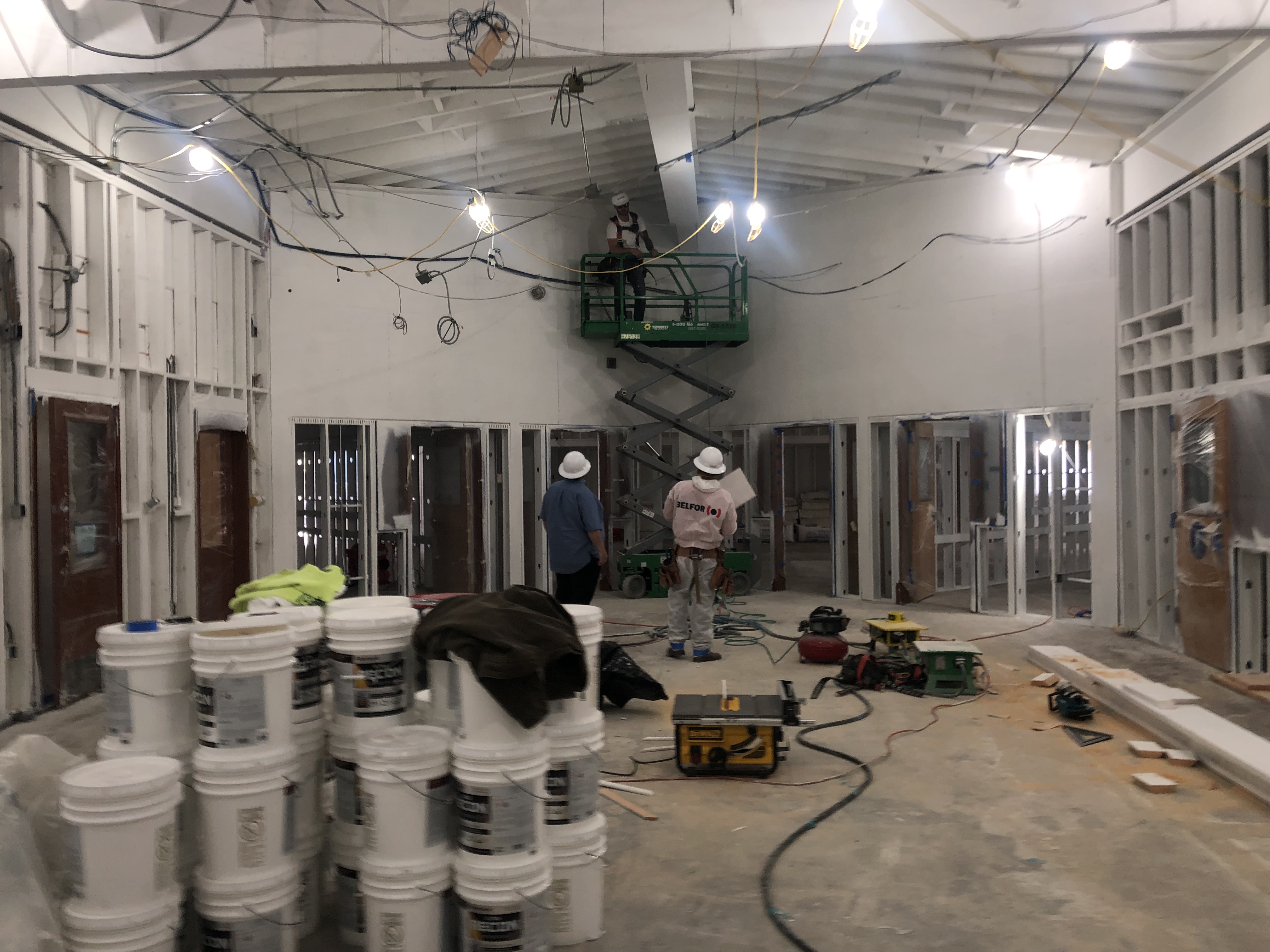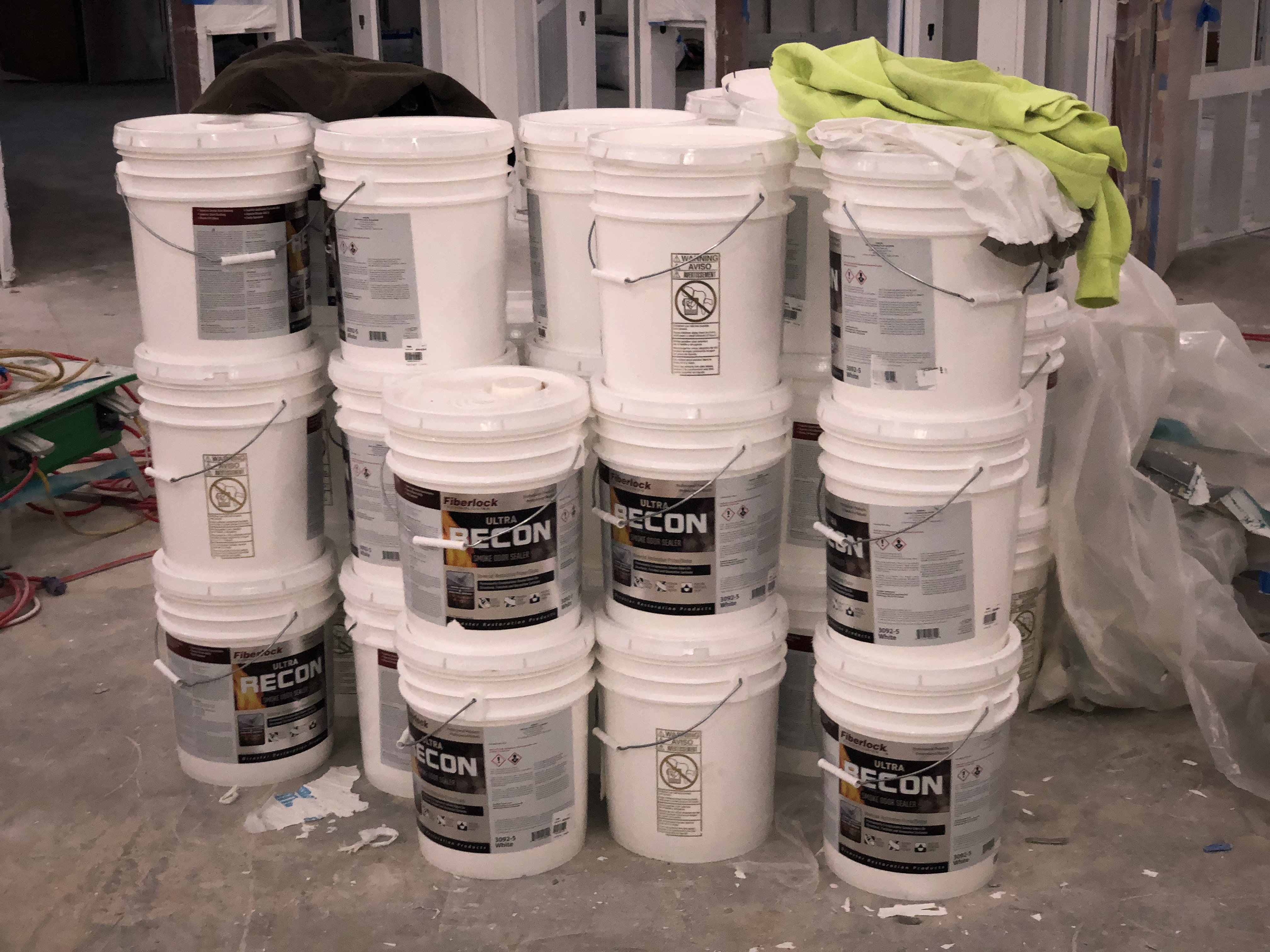
Clean, Deodorize, Seal
On November 11, 2018, the Sierra House Elementary School, in South Lake Tahoe, CA, suffered a fire. Only a portion of the building was damaged, and most grade level classrooms were not directly affected.
This facility is part of the Lake Tahoe Unified School District (LTUSD). The District moved quickly to secure qualified assessment and remediation professionals. In clearly unaffected areas of the school, conducting immediate and proactive basic soot cleaning, and getting reassuring results from air testing enabled a return of students to an improvisational but functioning school by December 3.
But the restoration of the burned and contaminated area would take longer. In fact, the normally scheduled winter holiday break would be fortuitous as it provided more time for the contractor to work unimpeded, and keep a very aggressive completion schedule for the restoration. After tear out of unsalvageable material, and the preliminary steps described below (like analysis, testing and mobilization), the consultant and restoration contractor together conducted a by the book fire damage restoration that followed the three fundamental actions: CLEAN, DEODORIZE and SEAL. Of these, the application of a sealer to restrict future emanation of smoke odor sounds simple, but there are key choices including the chemistry and performance attributes of the sealer. At the Sierra House Elementary site, the decision to utilize Fiberlock’s ULTRA RECON Smoke & Odor Sealer was made collectively as a change away from a decades-old, but problematic traditional product: alcohol-borne shellac.

RESTORATION BEGINS – EARLY PHASES
The restoration phase timeline began in November 2018. Adhering to best practices, the LTUSD hired an independent consulting professional, referred to in industry standards as the IEP (Indoor Environmental Professional), taking care there was no relationship with the remediation contractor. Fortunately, a qualified IEP firm, Premier Environmental, was based locally, and provided on-site expertise in engineering, industrial hygiene, and fire/smoke damage assessment. To collaborate with the IEP, and act as a liaison with the school system, the LTUSD made available an in-house Recovery Project Manager, also with engineering and environmental background. The District Architect was also brought in for consultations.
The remediation contractor already selected was Belfor – annually the largest or near the top of restoration contractors worldwide, and who had an office with experienced fire professionals in nearby Stateline, NV. Belfor also could provide abatement services for asbestos and lead if needed. Initial response decisions and speed are crucial in mitigating the degrading effects of smoke damage, and the Belfor Stateline crews swung into action immediately. Areas directly affected by the fire were isolated, and air movement with carbon filtration (to remove contaminants and reduce odors) were implemented strategically, including proactive air scrubbing in the areas not impacted by the fire. By the beginning of December, the scope was more extensive, and Belfor had an experienced project manager with fire damage expertise flown in to run the remediation full time.
By the end of November, the consultants (Premier) were finalizing the protocol for upcoming soot cleaning based on surveys and analysis of the site. These surveys included determinations concerning any potentially hazardous materials, such as asbestos and lead paint, not directly related to the fire but required by regulation. Lead testing with an XRF instrument found no lead in paint or tile in any of the affected areas. But a door in the contaminated burn area had tested positive for asbestos, was damaged by the entering fire department such that now friable asbestos fibers (friable is prone to becoming airborne and inhaled) were potentially present. Standard asbestos protocols were initiated and the area was abated by removal of the asbestos-containing material (ACM), then cleared after negative results from additional air testing. Meanwhile, the LTUSD decided to have the air quality tested by a method using sample canisters shipped to a laboratory for identification (if possible) of all detected Volatile Organic Compounds (VOCs). Upon receipt of the results, the IEP/consultants summarized some good news for the school, students and parents:
“VOC sample results came in. As expected, the presence of various Volatile Organic Compounds were detected in each sample, however all concentrations were … found to be well below these regulatory levels. All lab results are provided in PPB (Parts per billion by volume). Note: Many of the VOCs found are also found in over the counter household cleaning products and personal items (i.e. acetone, isopropyl alcohol, etc). These can also be in every day items used in schools, dry erase markers, sharpies, etc. A few of the VOCs found in the samples are also found in citrus odor masking agents and perfumes….” [these latter VOCs were attributed probably to odor counteractants used during the fire deodorization process].
In mid-December, Belfor was able to attack the remediation of the impacted area with a full-scale effort. A letter from the school to interested parents and others described the process and objectives as:
“Work will begin on Wednesday December 12th and will include the replacement of ceiling tiles and other porous materials; deep cleaning within the attic space; and restoration of the HVAC system and duct work in the source area, hallways, and restrooms. The goal is to complete the remediation and odor abatement prior to January 7th, when students return to school after the winter break.”
By December 11, the contractor’s trailers and Conex containers were arriving, and by the 17th Belfor had setup a cleaning area outside the building to detail clean contents from classrooms. Same week, the elementary school moved to an alternate site for the last week remaining before winter break. This gave Belfor and Premier an unoccupied building to work with.

CLEAN, DEODORIZE, SEAL: FULL-SCALE RESTORATION
The three fundamentals of fire damage taught in the ICP Masterworks training for Fiberlock installers and specifiers are CLEAN, DEODORIZE and SEAL. Of these, cleaning, is paramount. Consistent with the other major property damage disciplines (e.g., like CLEAN, KILL, COAT in mold remediation), the fundamental principle of fire restoration is source removal – i.e., there is no substitute for the hard work involved in removing contaminants from combustion. These residues, also known as PICs (Products of Incomplete Combustion), like soot and ash, are obviously detrimental to appearance and aesthetics. Another major concern is the degradation caused by corrosive residues. When cellulosic (wood, paper) components and contents burn, nitrogen compounds are released that combine with the fire department’s extinguishing water to form nitric acids. With plastics, the bad actor released is generally chlorine forming chloric acids (such as hydrochloric acid) with the water. Another reason cleaning is crucial, and the faster the better, is because of the damaging effect of acids as PICs.
A growing concern is very toxic residues. Data plus experiences are accumulating that indicate combustion residues often involve toxics of serious concern. These are substances we clearly don’t want in our indoor environment, such as polyaromatic hydrocarbons (PAHs), strong active solvents (benzene, toluene, naphthalene), furans, dioxins, and phenols. Removing these toxins wherever possible is another reason to clean and then clean some more.
And then there is the smell. The most insidious residue from fire is smoke odor that can reappear in a restored property many months after work is complete. Carried by the pressurized smoke, and deposited onto and into everything as soot ash, and oils, the odor can vary substantially in manifestation and intensity depending on the fire. Every fire is its own unique project, but unless properly addressed, a consistent worry is that any structure fire can result in residues which release smoke odor and irritants indefinitely. Post-fire odor has many negatives. Obvious is that it is unpleasant. For those emotionally impacted by the fear and loss associated with the fire itself, the smoke odor return can be traumatic. While unique to the intersection of each individual with each fire, there can be contaminant substances associated with the smoke odor that act as an asthma trigger, or even play a role in more serious health issues.
The aforementioned collection of fire-associated impacts calculate toward the value of a sealer, and the features, functions and benefits the chosen coating needs to deliver. In a perfect world, the cleaning process would be so straightforward, without complications and 100% effective that a sealer would be unnecessary. Of course, in a perfect world there would have been an efficient fire that consumed its fuel and left no PICs behind. Instead, in our imperfect and inefficient reality, the sealer is a necessity and truly the final step of the professional deodorization process in general, and which was specifically performed at Sierra House Elementary.
Some deodorization takes place through the initial demolition and removal of what can’t be saved, and then more odor-rich residue is removed through cleaning. This initial phase is often labeled Subtractive Deodorization. After source removal, a variety of chemical deodorizers are available to address residual odor: masking agents, perfumes/scents, fixatives, and counteractants that chemically change the odor (typically metazene-based solutions that react with and change combustion compounds associated with odor). Then, after all the effort involved in the CLEAN phase, and the target treatments chosen to DEODORIZE, the final step – SEAL – is more necessity than option, and that importance has been recognized for decades by the restorers that traditionally have finished fire jobs with copious gallons of alcohol-borne shellac. That was the habitual reflex that led to a few pallets of shellac delivered to the Sierra Elementary jobsite initially, but that product would end up returned.
By January 5, progress had been made, if not quite enough to reopen the structure. Another bulletin to parents described the project status as:
“Work that Belfor has completed over the Winter Break: All corridors have been abated. Lower pod is being cleaned again, including duct cleaning in each room and is sealed off from other areas of the school so there is no cross contamination as abatement and construction continue. HVAC units for portables have been cleaned. The admin office is being prepped for ceiling demo… Upper pod abatement began today (January 4th) and will go 7 days a week until complete.”
The anticipated completion date had been January 7th, but the schedule had to extend because of a development common with fire restoration – the discovery of more smoke residue on wall cavity insulation that was thought uncontaminated, but now would also require cleaning, soot removal and sealer in the cavity, and finally reinsulation and reconstruction of the wall. In fact, this delay scenario would repeat numerous times in January and February 2019. When fire damage restoration professionals claim their specialty is demanding and sophisticated, one persuasive justification is the difficulty achieving an accurate map of the spread of soot. Fortunately, Belfor’s depth of resources could compensate with additional skilled workers and equipment.

APPLICATION OF THE ULTRA RECON SEALER
By March, technical experts from Fiberlock had been to the project twice to support a collective decision on the project to move to a water-based smoke odor sealer, provided it would work as well as the shellac, and would be supported by the manufacturer. Both Premier and Belfor had extensive previous experience working with Fiberlock products and field staff on mold, water, hurricane, flood and fire projects. Both were confident support was available.
For this case study, the principal owner of the Premier consulting firm, Nate Seward, PE, CIH was asked about the thought process behind considering RECON instead of shellac. The following is his response provided with his permission:
“Due to the concerns of environmental hazards related to this fire loss, we performed comprehensive environmental air and surface sampling throughout the school site, revealing the fire-related contamination and necessary remediation was much more extensive than originally thought. Our protocol recommended the removal of impacted walls and ceilings along with HVAC systems so that remediation and cleaning procedures including HEPA vacuuming of soot, ash and char particles could be performed. Knowing that the detail cleaning and remediation procedures of these building surfaces was somewhat limited to the exposed surfaces only, there was concern about how to address the interstitial spaces (i.e. between framing members, under sill plates, etc.) and also the penetration of smoke odors into porous wood materials. Therefore, we recommended the contractor use the Fiberlock Recon product in accordance with the manufacturers specifications to be applied to seal the wood framing and/or other structural building materials impacted by the smoke damage after the cleaning process was performed. We recommended the Recon as a water-based sealer based on our knowledge, experience and understanding of its effectiveness and specific design for sealing smoke related odors, in addition to the added benefit of the manufacturers warranty.
After inspecting the application of the Recon product within the school, we are extremely pleased with the success of the product as a smoke sealer.”
To supplant shellac, the challenge for a water-based product is to offer equal reliability in sealing smoke odor and to reliably seal stains. If that can be demonstrated, then there are several advantages to a water-based formula. From a Building Science perspective, shellac can cause condensation and mold issues because the dry film is a total vapor barrier. While shellac blocks stains and smoke odor, it also stops that surface from breathing the way buildings often need to. For the specifier, there are further benefits to a water-based option: lower odor, lower VOC, and the sealer is non-combustible. That last advantage can be a very important worksite safety issue. For example, the shellac originally shipped to the site has a flash point of 54°F (12°C). In Lake Tahoe in March it wasn’t hard to imagine ambient temperatures right around that flash point, and on a construction site ignition sources (such as a power switch on a worklight) are inevitably everywhere.
From the installer’s view, replacing with a water-based product is a welcome change for many reasons, most of which relate to ease of use. The Personal Protective Equipment (PPE) requirements are simpler, especially in tight spaces, which in attic spaces were present at Sierra House Elementary. Soap and water cleanup is significantly easier and quicker than the gummy, often frustrating and always time consuming cleaning of equipment and lines with denatured alcohol. Time is money, and another expense associated with shellac is the extended time required to run air movers and scrubbers to remove the powerful alcohol odor that dwells in a structure, often for days. Water-based products can have less odor at the outset, far lower VOC content, and the project can move forward to reinsulation and reconstruction of the wall system faster. Taken altogether, shellac’s inconveniences previously accepted as necessary evils because there was no alternative, now become costly ad avoidable with a water-based competitor that works as well or arguably better. The development of ULTRA RECON by Fiberlock liberated the fire contractor, delivered the advantages of water-based formulation, and importantly, the building could continue to breathe as intended.
Advancement in technology are often accompanied by an increase in cost. As described, the water-based ULTRA RECON certainly delivers labor savings (even if just counting the cleanup), reduced costs in PPE and engineering controls (Ventilation), but what about the material cost of the product itself? Further good news for all involved is that the ULTRA RECON price delivered was actually $8 less per five-gallon pail ($1.60/gallon) than the shellac that ended up returned. Because the manufacturer was able to turn around hundreds of gallons on very short notice and to a relatively remote location, any remaining arguments about product choice re: price or logistics were negated.
From February thru May 2019, Belfor crews applied the ULTRA RECON sealer in white as the final remediation step as their crews progressed through the fire damaged areas in Sierra House Elementary. Airless spray was the chosen method of application. Cleanup, as mentioned, was substantially easier, less expensive and less unpleasant. Maintenance and application with airless spray equipment was also improved. Simpler spray equipment and settings were practical, the hybridized acrylic resin system caused no noticeable tip wear or overspray, and none of Belfor’s spray applicators reported clogged spray tips. When the Fiberlock Area Manager, on visiting the jobsite, asked what amount roughly was saved from all these factors, there was broad consensus. Belfor considered labor & materials savings (less down time, no thinner, less wear and tear, lower PPE, no odors, etc.) and the consistent answer was replacing the traditional shellac with Fiberlock’s ULTRA RECON saved them 20%. For a relatively simple change out with multiple upside benefits, the contractor expressed that the choice was obvious, and a decision they would make again in the future.
One final note: The neighboring Presbyterian Church had also experienced a fire and needed restoration. Impressed, the church leaders asked Belfor to conduct their restoration, including using the same sealer.
For additional information, visit www.icpgroup.com


